
A dusty, non-descript Himalayan village that once provided resting ground for travelers on the historic Silk Route between Kargil and Skardu, now lies shelled by the two warring nations, who very well know their hips are welded with common culture, language and religion but choose to live in absolute denial, scratching each other from time to time. The effects of Partition of India and Pakistan live on, with militarization and separation of people of one race and language.
At Kargil (India), I made a point to get close to the border. Just below the road, tucked strategically in the shelter of the valley, we could see the Indian military helipad. Soldiers and war machines were visibly perched on mountain tops across both sides.
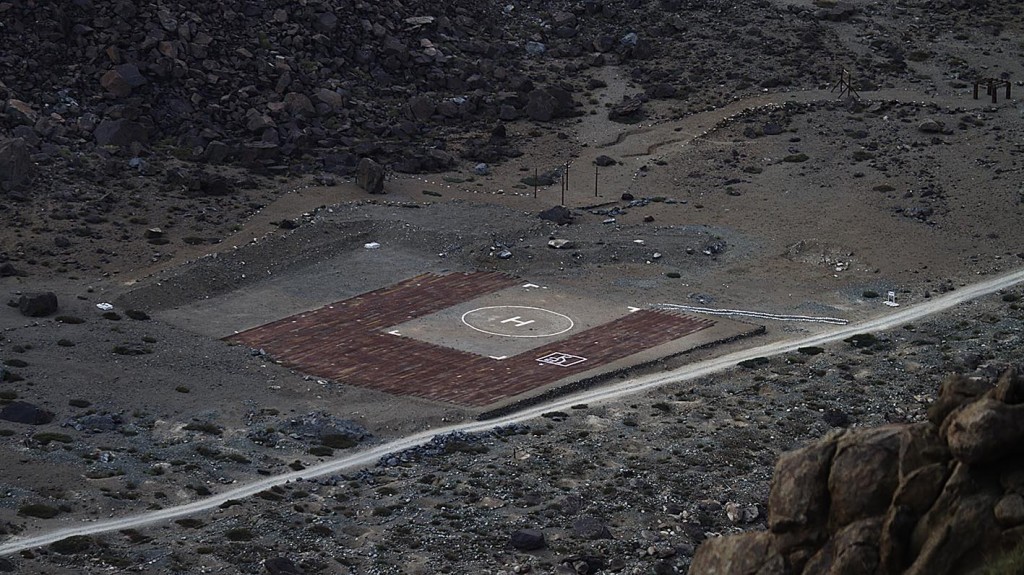
Photo : Helipad near Hunderman Blok
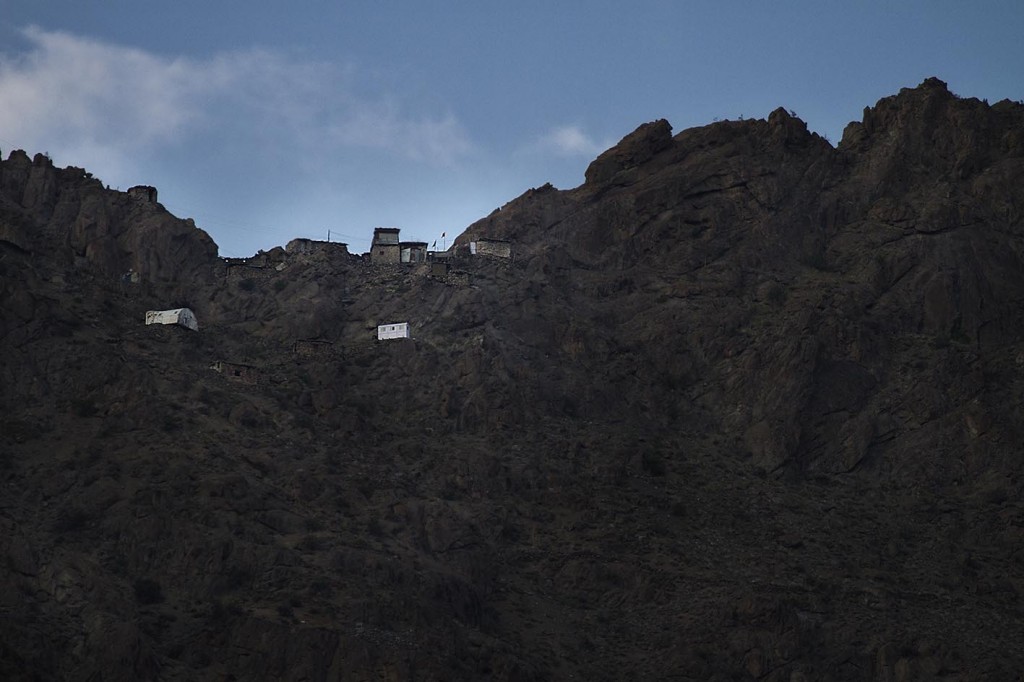
Photo : Army pickets on top of the hills
The sun was about to set, creating a play of colors in the sky. I had a calling to stop here for a moment to appreciate the gushing sounds of Shingo river. A short distance of less than one kilometer by crows flight, I could see Brolmo, the Pakistani village. Here the cultivation terraces and village homes were perched alongside Shingo river. The waters of Shingo required no passport to cross the borders created by the two nations. From the Pakistani village, Brolmo, river Shingo’s water gushes towards Hunderman Brok, the Indian village.
As I aimed my camera to capture an isolated mosque, built above Brolmo village, the engine sound of a small vehicle caught my attention. Just behind me, a Balti father – Balti is the race living in the geographically divided region of Kargil, Gilgit, Skardu and Baltistan – with his four daughters, brought his car to a halt.
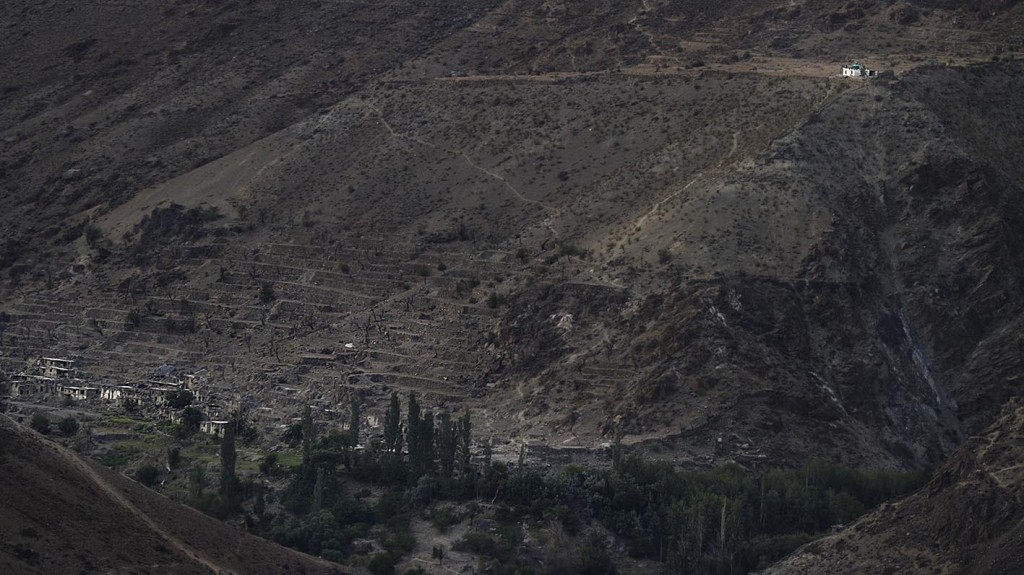
Photo : Terraced Brolmo village with Mosque at top
“Salam“, I said and he responded “Sat Sri Akal “!
Having broken the ice, this was the right opportunity to strike a conversation to get to know a bit more about the region.
Mohd. Hussain, man driving the car, was born in 1957, ten years after the partition of India in 1947. While Panjab and Kashmir regions saw the devil in man create a holocaust, the Shia Muslim dominated Balti region of Skardu and Kargil had no reason to be spilling blood. Hussain confirmed that his parents never mentioned any madness resulting in killing of innocent.
With signing of treaty of accession by the ruler of Jammu and Kashmir to join India, Kashmir saw tribesmen make an advance towards Srinagar to cleanse the region of Hindus and Sikhs. Gilgit and Kargil being far away from Srinagar, remained peaceful during this madness. With accession of Jammu and Kashmir to India, the Pakistan and Indian armies did not loose a moment to make advances, resulting in the defining line of control of 1947. At this time, the villages of Hunderman Brok and Bromlo, both came under Pakistan administration.
Mohd. Hussain recalls his childhood days, growing up in this region as a Pakistani citizen. Their home and tilling grounds were in Hunderman Brok, while he walked a few kilometers daily to Brolmo village to attend school. He pointed my attention back to the mosque over Brolmo village that I was photographing before his car caught my attention. That is “Sheikh Ali” mosque, which he used to visit as a child.
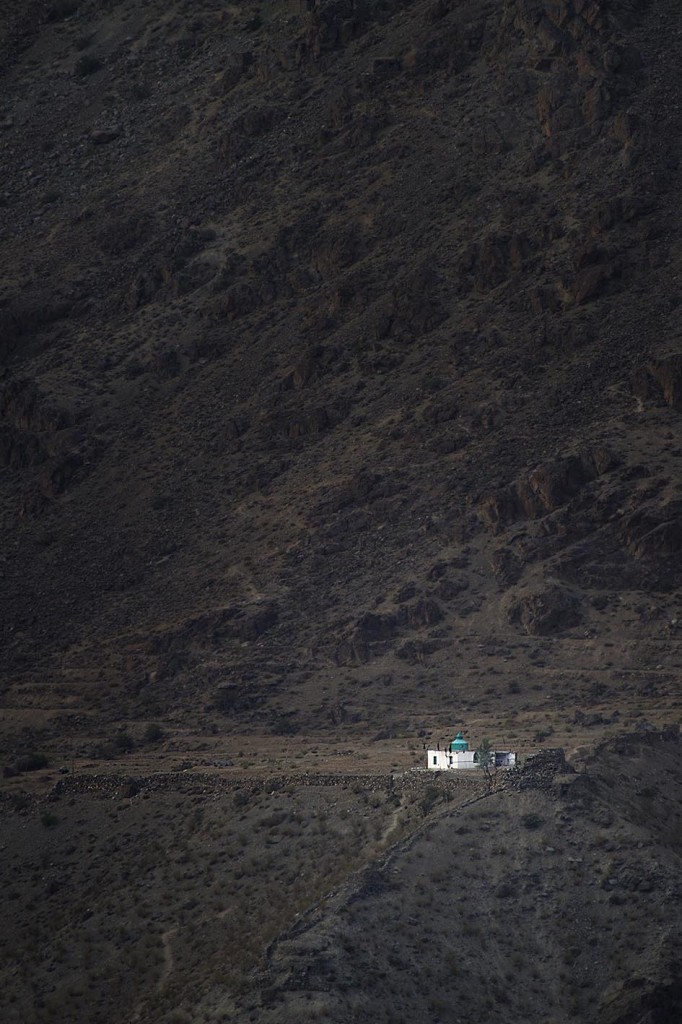
Photo : Sheikh Ali mosque in Brolmo, Pakistan
When Hussain was 14 years of age, the 1971 Indo-Pakistan war was fought and the Indian forces made significant advance in this particular region, resulting in his community getting split across the Hunderman Brok and Brolmo. By the end of this war, Hunderman Brok was in the Indian territory and Brolmo remained in Pakistan.
Thereafter, Hussain was never able to visit his school or the “Sheikh Ali” mosque in Brolmo because his village Hunderman Brok had now shifted to the Indian side and they were now citizens of India.
Such is the irony of border dispute that the Balti people, if they have to meet their relatives across the border, they now need to travel all the way south to Amritsar in Punjab, crossing the border at Wagah, entering Lahore and then drive back into Skardu – Gilgit region in Pakistan.
In the photo below, the green patch next to the river, just below where Hussain is sitting, the area in green is village Hunderman Brok in Indian territory. Further into the distance, nestled between the mountains, is visible another green patch, which is village Brolmo, in Pakistan.
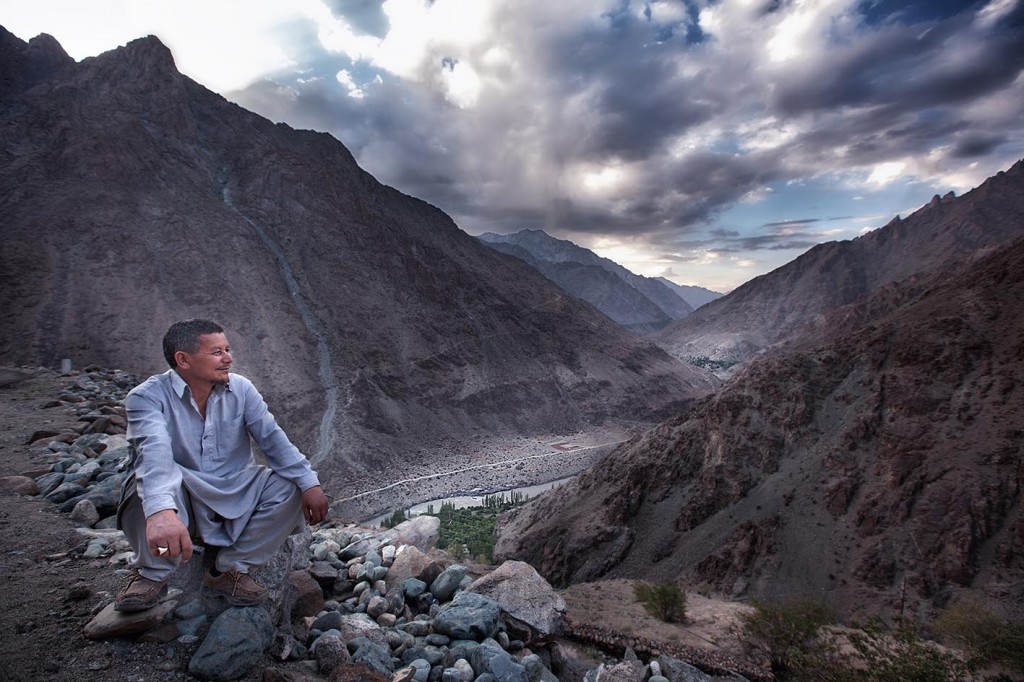
Photo : Hussain in foreground of Hunderman Brok & Brolmo
In photo below, on the left extreme (from viewers perspective), nestled between the mountains, the green patch is where lies the Pakistani village Brolmo.
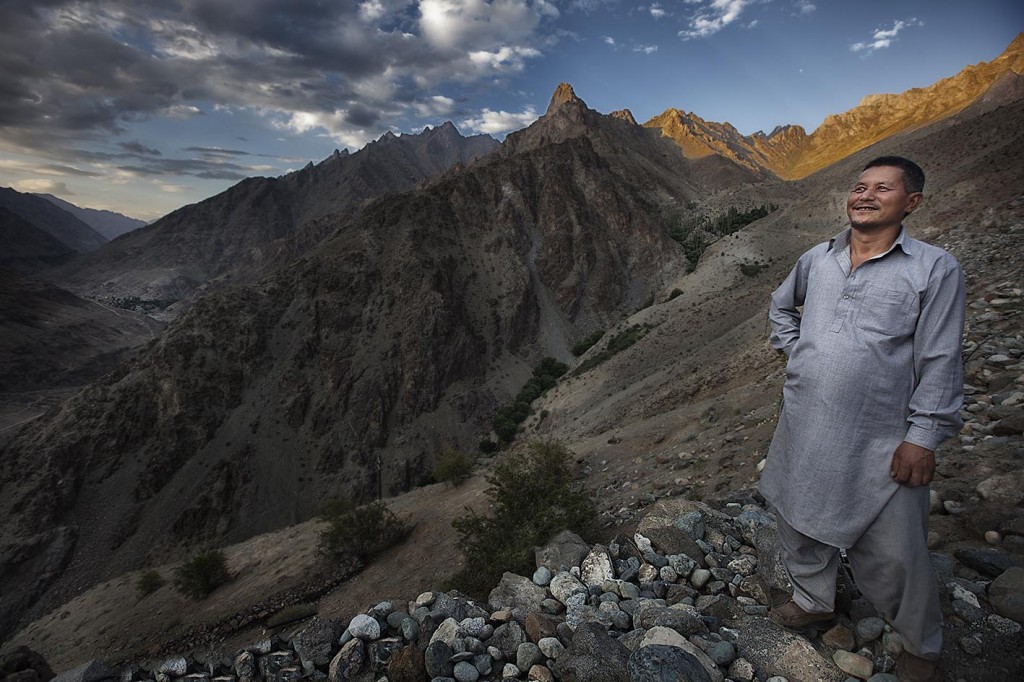
Photo : Hussain with Brolmo in extreme left from viewers perspective
As I photographed Hussain, his daughters were kind enough to heed my request to position themselves in the foreground of the two villages. Village Hunderman Brok in Indian territory lies to the left of the photo, as the green patch next to the river. Further into the distance, nestled between the mountains, is the second green patch of the Pakistani village Brolmo.
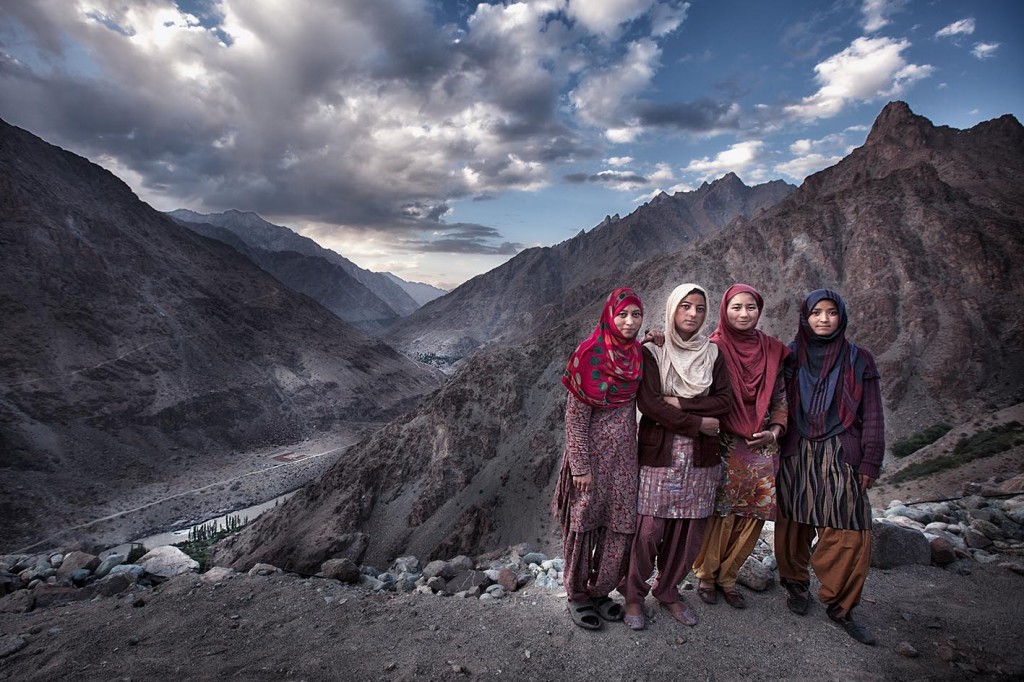
Photo : Hussain’s daughters in foreground of Hunderman Brok & Brolmo
We were loosing light at a very fast pace and I was able to get the last few photos of shelled houses in the region across both sides of the border. These looked like ghost houses. Hussain pointed to some areas in the mountains where lie bomb bunkers and he has personally taken refuge in these. To be honest, I could not spot these bunkers and that’s good because bunkers should not be easily noticeable.
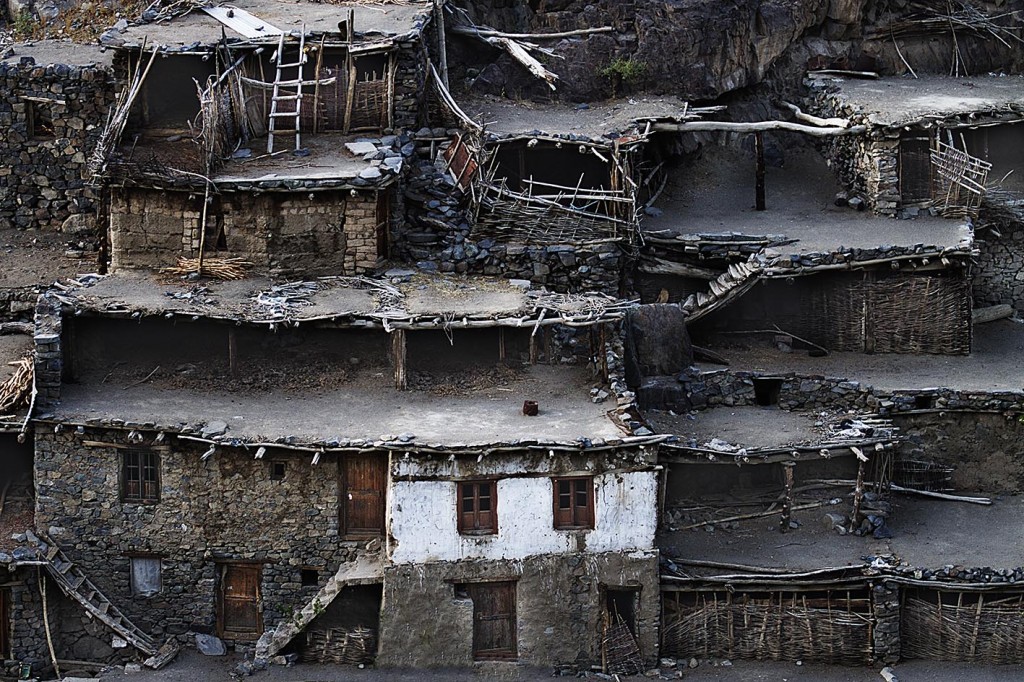
Photo : Shelled houses in Hunderman Brok
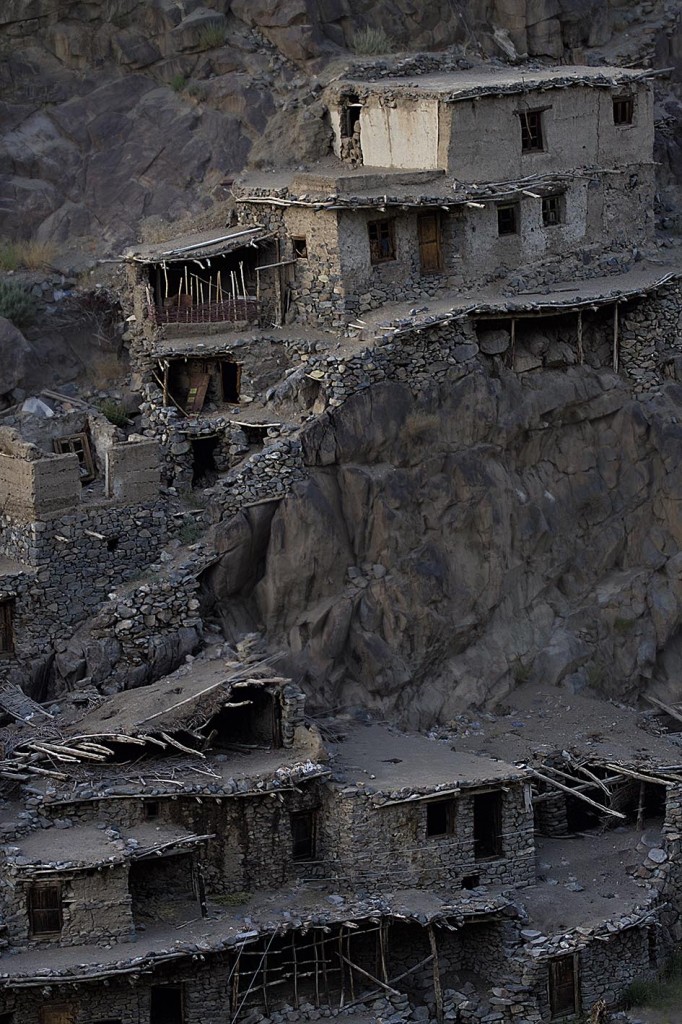
Photo : Shelled houses in Hunderman Brok
These few revealing and touching moments with Hussain came to an end and we went our ways. I could only pray that the political madness that have created these borders, impacting lives of common men, will one day come to an end.
I have hope, for every dusk is followed by a new dawn!

Comments(17)
sukhbir says:
September 19, 2014 at 11:26 PMVery touching indeed – the pictures and the words. Respect!
Karamjeet Singh says:
September 20, 2014 at 12:52 AMWar and attrition are enemies of civilization.Beautiful hills,streams,rivers and hillocks get mowed down by war machines.Your photos here showcase life and struggles of these village folks. Nice pictures indeed and the writeup is very informative.Good going as always,thanks for posting them.kjs
adarsh goindi says:
September 20, 2014 at 2:46 AMVery detailed insight to the area, ur pictures explain a lot….completely sympathise with the dwellers in these areas who suffer political consequences……..your work awesome as always!!
Troy Harris says:
September 20, 2014 at 2:24 PMI love the succinct, the laconic diction.
Dhruv Jolly says:
September 20, 2014 at 3:15 PMBrilliant assertion and Sensitivity on your part and as usual Brilliant photography … but a real Sad reminder of the Reality of what Happened and is happening even to this day… all for power, Control and Money … destroying lives, Cultures and Destroying Humanity … does not even figure in the mindsets of politicians of earlier times and Today. Much of it ( in the recent history) can be Attributed to The Imperial/British Empire … and it still exists … Unfortunately even though History teaches us … no one Learns or Choose not to Learn … ensuring Continuity of the wrongs … Really Sad … but then again Beautiful … from another perspective … Nature Lives On … Detached …
Dhiraj says:
September 20, 2014 at 7:08 PMAmardeep such a captivating story! You have this unique gift of transporting us to the location making us feel as if we are right there with the stark pictures and incredible diction. Great stuff as always.
Milton D'Silva says:
September 20, 2014 at 7:25 PMExcellent photo feature, and a heart warming story with heart rending moments. But the best part I like is:
“Salam“, I said and he responded “Sat Sri Akal “!
Ruchika Singh says:
September 20, 2014 at 7:32 PMWow brilliant as always.
Ash Nallawala says:
September 20, 2014 at 11:21 PMOne can learn so much from these non-political narratives. They show the practical realities of the locals who have to lead their lives dodging bullets fired over their heads and sometimes at them.
Salman Rashid says:
September 22, 2014 at 12:57 PMThank you, Amardeep. Thank you for bringing this beautiful story to the world.
Karamjeet Singh says:
September 24, 2014 at 8:38 AMWonderful coverage of terrains and tribes of hill people of remote war-zone of Kashmir India.Good work!!!
kishore kumar biswas says:
September 28, 2014 at 1:10 AMMd. Hussain and Amardeep Singh did not feel that they are ‘ enemies ‘. There are countless Hussains ans Singhs who feel the same . Then ” who ” are the people invented the theory of ” animosity ” between the ” two “?. They are the obnoxious politicians of the two countries who preach hatred to remain in power and to be rich without sweating. This theory serve their purpose , their evil design.
It is undeniable that in the course of history the ” partition ” was inevitable . But it was not necessary to nourish the mistrust and hatred . Fire does die if it is not kept rekindled again and again . The politicians did it purposefully. None of these politicians in both the countries did any good for their people.Instead of leading their respective countries towards a new enlightened horizon they pushed it in darkness , kept it captive into the prison of history.
In a sense they failed to influence Husssain and Singhs to believe in hatred . They failed to kill the love the traditional bond between them . dirty politics failed to strangle the humanity.
This photo feature is sad melody of that humanity. That will never die .
Masood Akhtar says:
October 13, 2014 at 9:13 PMI read whole blog accompanied the photographs. It was very moving. In fact I so seized and buried that I barely noticed that I was drinking tea which went unnoticed even after finishing the blog.
In every area this cleavage exists. But this bifurcation could not divide the common culture that exists for thousands of years. Our custom & costume, likes & dislikes, sense of beauty & ugliness are still the same. It does not matter to people whether they are watching Pakistani dramas or Indian ones.
At one time in our school when I was in high school, our teacher was talking about how our forefathers overran Spain and conquered the major part of Europe. I stood up and politely said that sorry sir they were not our forefathers they were Arabs with distinct mindset. Unfortunately our forefathers were ones whom we broke away. This infuriated the teacher. At another time when our principal was saying that with the passage of time both Indian Urdu and Pakistani Urdu would grow to be different language. I said no and never because by that time satellite communication would increase to the extent that both languages would become one instead of two different ones. Satellite communication and internet is bridging the gap. It is bringing both the communities together. It is time testing fact that people to people contact always help bridge the gap.
Shabbir Hussain Brolmo says:
November 16, 2015 at 9:16 PMSo Nice Block about Brolmo
Ajay Tripathi says:
May 4, 2016 at 5:31 PMA very serious issue presented in most simple way for any one to understand the pains of war and separation. Beautiful photos especially the two villages far away speaks itself.
Gurdial Singh Raina says:
June 11, 2017 at 1:07 AMPeople at such areas are deprived of the happiness of modern world. & their simplicity is displayed. But such Areas have already made significant presence by winning Noble peace award. Malay is A proud daughter of this area.
Asgar Ali says:
July 6, 2017 at 3:35 PMThank you amardeep for bringing the facts to the world. I myself from there know how much difficult it is to live in a war zone..Hope one day there will be no border all over the world and all human irrespective of nation and religion will live with peace.